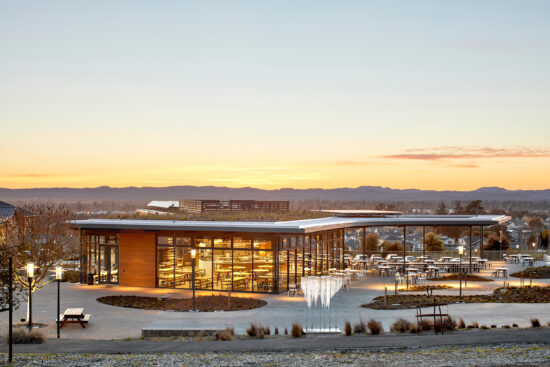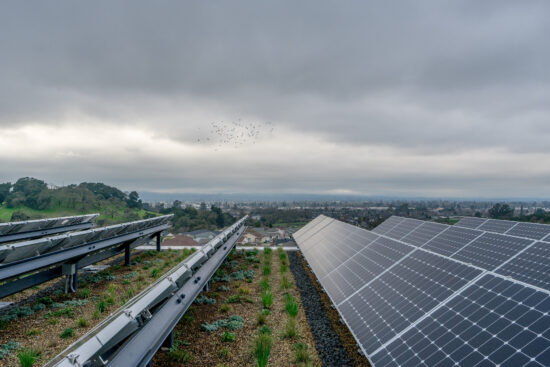Another win for Sonoma Academy – the school’s Janet Durgin Guild & Commons recently won a Beyond Green High-Performance Building and Community Award from the National Institute of Building Sciences. This is on top of its achievement of the AIA CC Leading Edge Award and AIA COTE Top Ten Award, the industry’s best-known award program for sustainable design excellence. Designed by WRNS Studio as part of a campus-wide expansion, the Project integrates biophilic principles which are part of a larger approach to nature-and-human-centered design focused on active and passive systems that encourage environmental, social and community conscious learning and living.

Per WRNS Studio Partner, Director of Sustainability and Project Manager, Pauline Souza,
The project is a story of possibility, demonstrating the power of teamwork, sustainability and inspiration. The beauty of the site, and school’s commitment to the community and to the environment, informed the building’s structural and sustainable stylishness.
The new 22,000-square-foot building houses maker and digital media studios, student support services, indoor / outdoor dining, an all induction commercial kitchen, and a teaching kitchen / meeting room that overlooks the school’s productive gardens and the maker classroom patio.

According to the jurors,
This project demonstrates that, even with an energy-heavy program that includes a commercial kitchen, a fully integrated and dedicated design team can produce a beautiful and extremely well-performing building.
Sonoma Academy’s guiding principles of creativity, inclusive community, exploration and innovation, coupled with a humanistic approach to education, was the inspiration for the two sweeping floors that begin in the heart of the campus and face the horizon with amazing views of Santa Rosa. Sliding screens, automated shades, visible radiant system controls, and deep overhangs relay how the building responds to climate. Regionally-sourced low carbon block, ceramic tiles, reclaimed beams, and exterior and interior sliding, pair with regionally-made lamps and furniture to celebrate community. The living roof attracts pollinators, houses photovoltaics, and connects to tiered planters that filter greywater and stormwater for reuse.
The project is seeking LEED Platinum, ZNE, WELL Education Pilot, and LBC Petal certifications. It’s the first project in Sonoma County and one of the few to use these benchmarks simultaneously.

Last year, the WRNS Studio-designed Sonoma Academy was honored with the California ZNE School Leadership Award: a project among six winners recognized for driving ZNE in new and existing school projects in California.
Six exemplary individuals, design teams, and school districts were honored with ZNE School Leadership Awards for their innovation and leadership in driving a new zero net energy (ZNE) standard for school environments. California is leading the United States in the transformation of K-12 and community colleges to ZNE performance with over 40 ultra-low and zero net energy schools in operation or planning. To showcase early adopters and change-makers in the K-12 schools and community colleges market, California’s investor-owned utilities in partnership with the California Public Utilities Commission and other agencies, established the awards and recognition program, now in its second year.

Sonoma Academy’s AEC Team won the award for the “Team ZNE Leadership” category for the school’s new Guild & Commons project designed by architecture and planning firm WRNS Studio. The AEC team is changing the status quo, taking an integrated approach in every step of the design-build-post-occupancy process, including educating the community, empowering stakeholders and policy makers, and challenging their own industries to target multiple benchmarks. The team includes Rick Theis of Sonoma Academy; Pauline Souza of WRNS Studio; Courtney Lorenz of XL Construction; Hormoz Janssens of Interface Engineering; and David Kaneda of Integral Group.

Sonoma Academy developed an ambitious agenda for its new Guild & Commons project, embracing three benchmark systems: LEED Platinum, Living Building Challenge, and zero net energy. Designed to help students be critical thinkers and practical doers, the Guild & Commons building is a story of the region’s architecture, landscape, people, sustainability, and everyday life. The project is projected to achieve a net positive EUI of -4.85 kBtu/sqft/year!

ZNE School Leadership Award winners were selected by an esteemed judging panel of industry representatives and considered based on demonstrated achievement that a project has attained or is on track to achieve ZNE performance, or is providing leadership and a model for others to learn from. The six 2017 categories and winners are:

VISIONARY DISTRICTS have utilized policies or plans that results in larger scale advancement of zero energy buildings: San Francisco Unified School District and Garden Grove Unified School District
OUTSTANDING BUILDINGS are ZNE verified, ZNE emerging, or ultra-low energy projects at K-12 schools and community college campuses: Playa Vista Elementary School, Los Angeles Unified School District | ZNE EMERGING and Bishop O’Dowd High School Center for Environmental Studies | ZNE VERIFIED
ZNE LEADERS are individuals who inspire others on the path to ZNE and project teams that work effectively together to achieve ZNE goals: Alexis Karolides, Point Energy Innovations | INDIVIDUAL ZNE LEADERSHIP and Sonoma Academy’s AEC Team | TEAM ZNE LEADERSHIP
Learn more at: https://newbuildings.org/zne-awards/

ABOUT ZNE SCHOOLS IN CALIFORNIA
With energy bills at California’s K-12 public schools totaling more than $700 million a year, according to the California Energy Commission (CEC) Consumer Energy Center, innovative energy-saving solutions are needed to manage costs. Schools built and renovated to ZNE performance have substantially lower energy costs and over time save money on energy bills that can be spent on students and programs. In addition, K-12 schools and community colleges represent key opportunities for ZNE projects. New ZNE schools already exist in many states across the country and a variety of climate zones, with some of the best examples being built for the average costs of traditional school construction. As local examples of the feasibility and benefits of ZNE continue to increase, schools are an important platform to educate the broader public about sustainability, and demonstrate a commitment to reducing climate impacts.

ABOUT THE ZNE RECOGNITION AND PROPOSITION 39 ZNE SCHOOL RETROFIT PILOT PROGRAM
The California Energy Efficiency Strategic Plan has set ambitious goals for achieving zero net energy (ZNE) for all new commercial buildings by 2030. To support these ambitious state goals, a Proposition 39 ZNE School Retrofit Pilot Program is providing California’s existing schools ZNE financial resources that can help transform some of the state’s K-12 and community college buildings to ZNE. The ZNE Schools Awards program and workshop are part of this Proposition 39 pilot effort and is supported by Pacific Gas and Electric Company, San Diego Gas & Electric Company, Southern California Edison and Southern California Gas Company. The Proposition 39 ZNE School Pilot Program includes new schools case studies, ZNE trainings, and financial and technical support for a variety of school retrofit demonstration projects to showcase how existing K-12 school and community colleges can be transformed to ZNE performance.
This program is funded by California utility customers and administered by Pacific Gas and Electric Company, San Diego Gas & Electric Company, Southern California Edison and Southern California Gas Company under the auspices of the California Public Utilities Commission, through a contract awarded to New Buildings Institute. The trademarks used herein are the property of their respective owners.




Be the first to comment